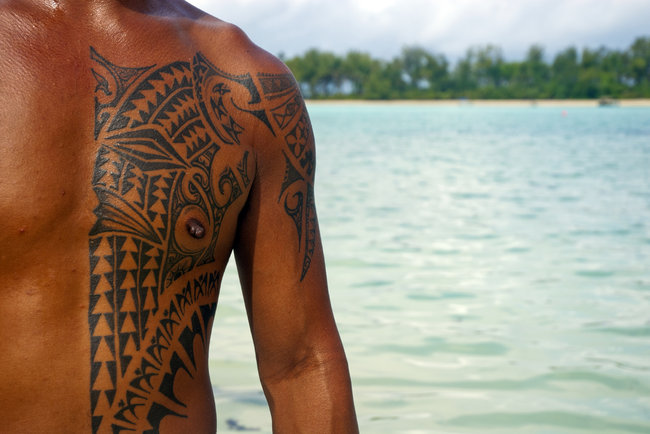“I shall
now mention the way they mark themselves indelibly, each of them is so marked
by their humor or disposition”. Joseph
Banks
Before the explanation of the tattooing history itself, it makes sense to explain exactly where it all began and give a brief description of the culture surround Polynesian tattoo history.
The
origins of Polynesian culture still fuels a large number of debates, but one
thing that is certain is that Polynesia is made up of a number of tribes, not
just a single one. The Polynesian culture is built up from the following groups including, Marquesans,
Samoans, Niuaeans, Tongans, Cook Islanders, Hawaiians, Māori and Tahitians. These are all genetically
linked with the native peoples of parts of Southeast Asia.
This is a sub region of Oceania and all the islands
that make up Polynesia are within a triangle that has New Zealand, Hawaii and
Easter Island at each of its corners, grouping over 1,000 islands scattered
across the ocean.
The people of these islands have similar trends in language, customs, society and culture, causing them to be referred to as Polynesians. This is why you find different designs of what are considered Polynesian tribal tattoos; each sub-tribe has their own subtle features that make them unique.

Alvaro de Mendana de Neira, the Spanish navigator
and his team of European explorers, first visited the Polynesian Islands in
1595. The first of the islands visited were the Marquesas Islands but the
navigators found very little valuable resources so showed very little interest.
However, it was Captain James cook who explored the
entire Polynesian Triangle that brought back the word tattoo to Europe. His on
board naturalist, Joseph Banks was the first person to mention the word tattoo
in his journal. (It was also called ‘Tatau’ by Samoan and ‘Tatu’ by Tahitian
tribes). He wrote the quote that is at the top of this post in his journal.
When Captain Cook returned from his first voyage
the word ‘tattoo’ had appeared in Europe and he described the behaviour of the
Polynesian and called it ‘tattaw’. From his travels he brought back with him a
Tahitian named Ma’i and from the tattoos of Ma’i, tattoos started to become
rapidly famous.
It is also noted that the Polynesian tattoos were
popular with European sailors who would return home from voyages with their
bodies decorated with these tattoos.
In the 18th Century the tradition of
Polynesian tattooing, which existed from 2000 years ago, was strictly banned by
the Old Testament. It wasn’t until the early 1980s that Polynesian tattoos went
through a renaissance and since then many of the lost arts have been retrieved
by Polynesians. Unfortunately the tools were not sterilised properly to a good
standard and led to the ban of tattooing by the Ministry of Health in French
Polynesia in 1986.
Even thought this is an aged tradition, the tools
and techniques have hardly changed. The skill gets handed down from master to
disciple, father to son, for strictly traditional designs. Like modern tattoo
studios, each Polynesian tattoo artist, or tufuga, has to learn the craft by
serving many years as his master’s apprentice. Polynesians passed this
knowledge vertically to protect it because of its sacred nature.
A tattoo served a purpose as it delivered
information about its owner. It also was considered a method of harnessing
spiritual power, strength and protection. It also defined a person and would
show their character as well as positions and levels in a hierarchy. A tattoo
would display their spiritual power or life force, which they referred to as
mana.
The Polynesian masters were crucial tribesmen as
they memorised the meaning of every symbol and motif and knew how to
beautifully integrate them into meaningful work on the person’s skin. Sea
creatures are very common Polynesian symbols and each one has a different
meaning, such as mantas, sharks and sea urchins. These tattoo masters can
express a number of meanings by combining different symbols and motifs
together.
The styles of Polynesian designs varied from island
to island depending on the degree of the tribes evolution. The original styles
would consist of simple repeating patterns on the body, usually straight lines.
The meanings of these patterns are almost lost, or hotly debated. The most
popular style used these days is from the Marquesas Island and consists of
rounded patterns.
Tattoos and their location on the body would
determine a lot of different things in Polynesian culture and tattooing was
considered a sacred ceremony. They could show a person’s genealogy, position in
society and even personal achievements. The high ranking members of the Maori
Tribe were tattooed and the members of the lowest social level could wear none.
It has been said, from the basis of mythology, that
humans learned the art of tattooing from the sons of the God of Creation,
Ta’aroa. The origins of tattoo operation were originally handled by highly
trained shamans in religious ceremonies as they were experts in the meanings of
the tattoos. To qualify for a tattoo a person had to go through a long period
of cleansing that would involve a fast for a fixed length of time and no sexual
intercourse or contact with women. Warriors that wore these tattoos were
considered more attractive to women, as they marked important events and rites
of passage the warrior had been through.
These days modern tattooing uses the same basic
concept as these fantastic old traditions but the development of modern
equipment allows much more intricate designs. It is so much easier now to get
hold of good quality, safe tattoo supplies than it was for the Polynesians. If you have any
questions or want to discuss anything tattoo related contact us
on 01922 744088.